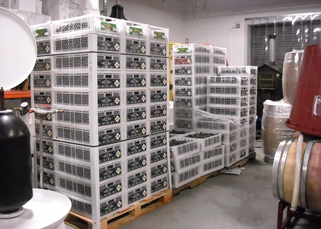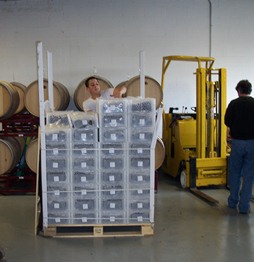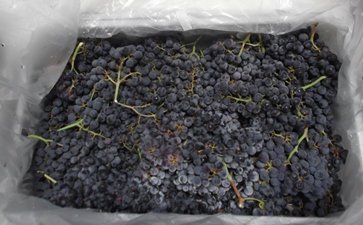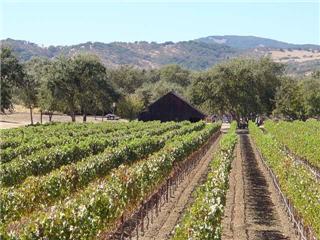

California vineyards are a major source for the Eastern wine making club or school. Each pallet of boxed grapes represents a ton and truckloads of pallets are shipped.
The Journey: California AVA's Deliver on Eastern Needs
Since before the well documented sourcing of grapes for Eastern US amateur - or home or personal - winemaking during prohibition, California vineyards have created steady supply. But that is just the start of the journey to wine, the grapes must first get to the East. There is an industry that has built around that and it is very vibrant even today.
by
Allison Siena
January 28, 2013
Wine consumption is growing in the United States and with it the desire of people to make their own wine. It follows then that wine-making clubs are starting to pop up in many of the larger metropolitan areas around the country, especially in the East. Who are the people choosing to make their own wine? And where are they getting their grapes?
It is an interesting and diverse group which includes both young and older wine enthusiasts…baby-boomer to millennial…lifelong lovers of wine and their grandchildren just now discovering wine bars. If you love wine, why not try to make it?
A growing trend in amateur winemaking is making it a group project. Weddings, for example. Most brides and grooms start planning a year in advance for their festivities; about the time needed to produce wine. Making their personalized wines can involve family and friends in a fun project which creates a unique party favor. It is becoming a corporate craze as well. Many companies are using winemaking as a team-building exercise that results in a corporate gift that the business made as a team. Clever companies use the labels as a means to broadcast their message to clients or even their in-house staff.

Despite living within an hour of the Long Island AVA and having traveled to vineyards throughout the United States and Europe, I had given little thought to what happens to grapes that a vineyard or grower will not be able to use. I had sourced must, the juice of freshly crushed grapes, but never the grapes themselves. There are plenty of resources available on careful vineyard cultivation, harvesting details, and the mechanics of winemaking, but there is very little information on fruit transport and off-site winemaking.
I had the pleasure of talking to Michael Pinto, owner of one of the companies, GinoPinto, Inc., that transports these grapes. GinoPinto is a New Jersey based international company which is a wholesale distributor of wine grapes and wine grape juice, as well as winemaking equipment and supplies. He is also a winemaker. The company is a major supplier of wine grapes along the mid-Atlantic region, much coming from California and as such often under appellation such as Suisun Valley, Sierra Foothills, Mendocino as example.

The biggest challenges facing the distributor are logistics and timing. From Michael’s point of view, he has greater control over the process because he is both liaison with the grower and the transporter of the grapes. He is involved in the picking, the packaging, and the transportation. It takes just about five days from California to the winery. (The longer time-frame mainly applies to regions outside California, such as Chile during our winter months.) Refrigeration from harvest morning to final delivery is key.
Of equal importance is the careful handling of the grapes at harvest. If the grapes are wet, for example, they are at risk for all kinds of problems ranging from rot to freezing during transport. The outside temperature may be 55-60 degrees but the transport is likely 34-35 degrees. In addition, if the grapes are sourced from several growers, proper cold storage is needed for the lag time between collection and transport. For California to New York transport, GinoPinto uses cold storage exclusively and uses no other preservative methods such as sulfur pads. Based on grape deliveries witnessed firsthand, as both an in-house sommelier and a winery customer, there is no difference in the grapes picked just five days before or even one month if they have been properly refrigerated and transported.

What we have found however is that those who participate in the winery cooperatives and DIY wineries such as mine can access the grapes from Suisun valley or other regions and make wines that show real regional diversity for themselves. If you can’t purchase it locally, make it yourself!










 READER FEEDBACK: To post your comments on this story,
READER FEEDBACK: To post your comments on this story,




